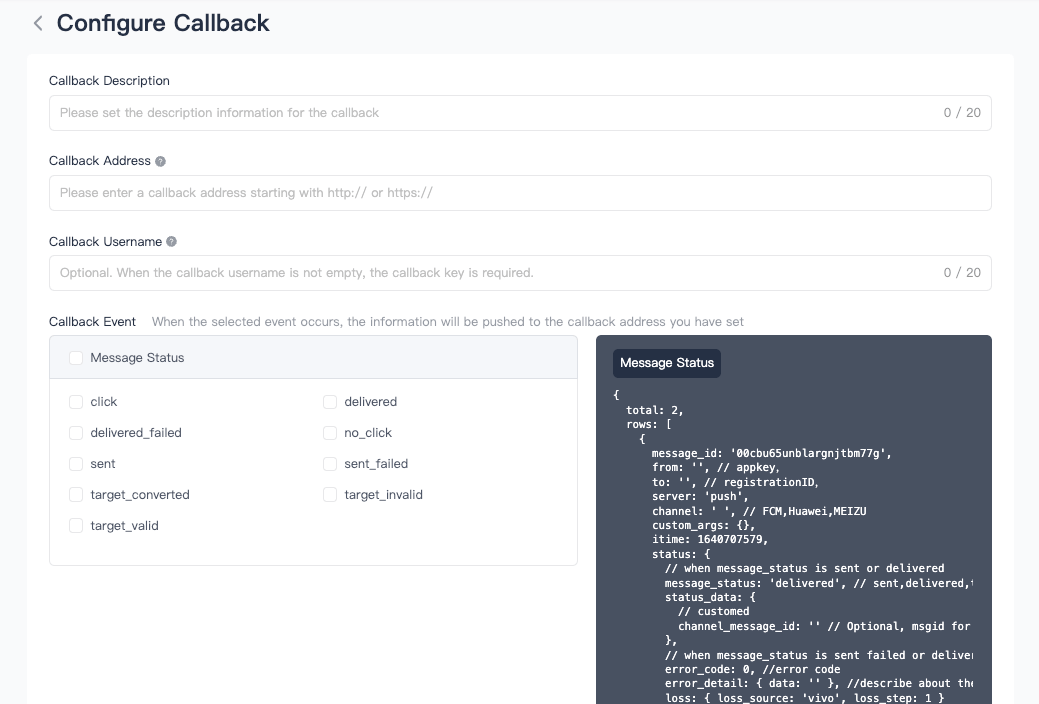Message Resending Strategy: Reaching Users with Intelligent Callbacks
I. Why is Message Resending Necessary?
In the mobile internet era, the average message delivery rate is only 65%. Users may miss important information due to device sleep, unstable networks, or distractions, directly resulting in wasted traffic and conversion losses.
II. Feature Overview and Advantages of Intelligent Callback Resending
To help developers achieve refined user operations and improve key metrics, EngageLab offers the following two core features to ensure every message reaches every user at the right time in a measurable way:
1. Push Callback: Enabling Data-Driven Closed-Loop Operations
The push callback feature upgrades message pushing from "one-way sending" to a "two-way observable" closed-loop system.
When you send messages through EngageLab, our service automatically sends status reports back to your designated business server (Callback URL) at critical points (e.g., delivered, displayed, clicked, failed to send).
Core Values
Accurate Effect Measurement: Accurately calculate delivery rate, display rate, and click-through rate to provide real data support for operational strategies.
Real-Time Status Monitoring and Automation: Based on user behavior (e.g., "click") callbacks, subsequent business logic can be triggered in real-time: For example: User clicks on a promotional notification → System automatically issues a coupon; User clicks on a chat message → App automatically navigates to the corresponding conversation page.
Intelligent List Maintenance: Automatically clean up invalid device identifiers based on "failed to send" (e.g., token expired) callbacks, improving the health of the push list and optimizing push costs and efficiency.
III. Industry Use Cases: Practical Applications in News and E-commerce
Case 1: News Industry — "Morning News Unread User Resend Plan"
Pain Points
- Morning push notifications are missed due to devices being off or notifications not being displayed → Read rate is only 40%.
- Urgent news requires secondary reach, and manual resending is inefficient.
Solution (EngageLab Configuration Rules)
Trigger Condition: Not clicked within 2 hours after the push is sent.
Resend Strategy:
- First Resend: After 1 hour Title changed to: "Exclusive for Unread Users: 3 Must-Read News You Missed Today"
- Second Resend: After 3 hours Added: "Hot Topics in the Comments Section: Latest Updates on XXX Event"
Data Results
- Overall read rate increased to 72%.
- Average user reading time increased by 18%.
- A leading news app: Daily new user retention increased by 25%.
Case 2: E-commerce Industry — "Reactivation Plan for Unclicked Users During Promotions"
Pain Points
- Initial push message click-through rate during promotions is only 35%.
- Resending requires manual filtering, which is inefficient and lacks granularity.
Solution (EngageLab Configuration Rules)
Trigger Condition: Not clicked within 6 hours after the push is sent.
Resend Strategy:
- First Resend: After 2 hours "Limited-Time Offer Countdown: Hot Items Running Out of Stock"
- Second Resend: After 5 hours "Exclusive Coupon: Save an Extra $5"
- Personalized Reach: Recommend products based on users' browsing history, such as "The iPhone accessories you’re interested in are now discounted."
Data Results
- Overall click-through rate increased to 58%.
- Resend users' GMV accounted for 32%.
- A beauty e-commerce platform's ROI during the 618 promotion period increased by 40%.
IV. Technical Implementation: EngageLab's Closed-Loop Push Capabilities
3 Steps to Start Intelligent Resending
1. Enable Callback Function in the Console

For configuration details, see Documentation
2. Create a Push and Bind a Callback URL
POST /v4/push
Authorization: Basic base64(appKey:masterSecret)
Content-Type: application/json
{
"from": "push",
"to": {
"registration_id": [
"120c83f760363f06840"
]
},
"body": {
"platform": "android",
"notification": {
"android": {
"alert": "Limited-Time Offer Countdown: Hot Items Running Out of Stock",
"title": "618 Promotion",
"extras": {
"newsid": 321
}
}
},
"options": {
"time_to_live": 60
}
},
"request_id": "12345678",
"custom_args": "business info",
"callback_url": [
"http://a8d4e974.topfree.cc/appCallback/notify"
]
}
3. Query push callback data based on msg_id, optimize the copywriting, and initiate the resending strategy
Five, Best Practice Summary
| Operation Step | Recommended Practice |
|---|---|
| Feature Config | Enable callback function in the console |
| Push Creation | Bind callback address when creating a push |
| Data Monitoring | Query callback data based on msg_id |
| Resending Strategy Formulation | Set trigger rules based on unclicked/undelivered statuses |









